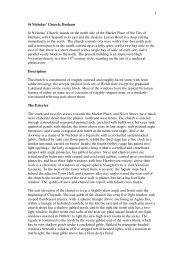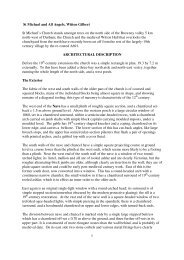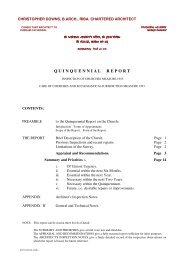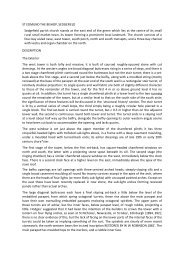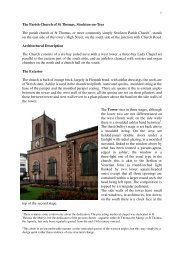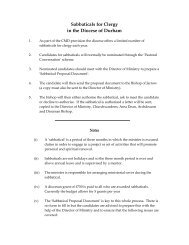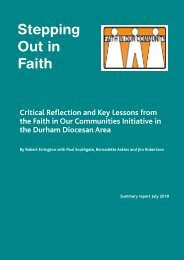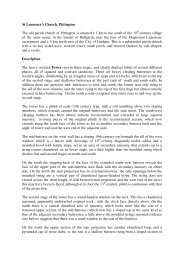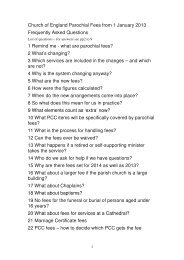St John the Evangelist, Kirk Merrington The parish church of Kirk ...
St John the Evangelist, Kirk Merrington The parish church of Kirk ...
St John the Evangelist, Kirk Merrington The parish church of Kirk ...
Create successful ePaper yourself
Turn your PDF publications into a flip-book with our unique Google optimized e-Paper software.
purlins, <strong>the</strong> longitudinal timbers having broad chamfers to <strong>the</strong>ir lower angles.<br />
Fittings & Furnishings<br />
<strong>The</strong> Font stands in <strong>the</strong> western part <strong>of</strong> <strong>the</strong> nave, and has a cup-like bowl on a ra<strong>the</strong>r worn<br />
turned shaft. Hodgson (1912, 211) describes discovering <strong>the</strong> bowl <strong>of</strong> <strong>the</strong> font upon <strong>the</strong><br />
vicarage rockery, and states that its lower parts had been ‘broken up into imitation rock<br />
work’; it had been replaced, presumably in 1850-1, by a neo-Norman successor which is now<br />
in <strong>St</strong> Peter’s Church, Byers Green (DOE 1988). Hodgson thought <strong>the</strong> font bowl possibly 12 th<br />
century; <strong>the</strong> DOE list more credibly suggests a 17 th century date. <strong>The</strong> bowl appears to be that<br />
described and illustrated by Hodgson; <strong>the</strong> shaft is somewhat damaged but hardly ‘broken up’<br />
as Hodgson stated..<br />
<strong>The</strong> furnishings within <strong>the</strong> nave and north transept are all <strong>of</strong> s<strong>of</strong>twood and <strong>of</strong> later 19 th<br />
century date; <strong>the</strong> pews have fleur-de-lys ends, and some have faint remains <strong>of</strong> painted<br />
numbers. None are <strong>of</strong> especial interest, except perhaps for <strong>the</strong> Eden Family Pew, moved in<br />
1986 to its present location in <strong>the</strong> transept , from <strong>the</strong> east end <strong>of</strong> <strong>the</strong> nave.<br />
<strong>The</strong> Organ, set against <strong>the</strong> centre <strong>of</strong> <strong>the</strong> north wall <strong>of</strong> <strong>the</strong> north transept, has painted designs<br />
on its pipes and <strong>the</strong> inscription ‘Holy Holy Holy’ across a top rail. A 1985 letter from Dr<br />
Donald E Wright (DAC Records) describes it as being <strong>of</strong> 1866, and by Wadsworth. It<br />
originally cost £200, and can be regarded as 'historically significant in several ways' .<br />
<strong>The</strong> Chancel Screen however is an important piece <strong>of</strong> c 1660-1670, <strong>of</strong> <strong>the</strong> Cosin school <strong>of</strong><br />
woodwork. <strong>The</strong> DOE list account (1988) describes it as having a ‘panelled dado, skittle<br />
balusters above support paired arches with cusped tracery; rinceau frieze below dentilled<br />
cornice with classical moulding; richly-carved fruit and flowers in principal vertical<br />
members; top swell cartouches flanked by scrolls and swags. This mixture <strong>of</strong> Gothic and<br />
Classical elements is typical <strong>of</strong> Cosin’s work; <strong>the</strong> upper elements are described by Pevsner<br />
(1983, 345) as ‘a crude version <strong>of</strong> <strong>the</strong> cresting on <strong>the</strong> Sedgefield chancel panelling with<br />
cherub’s heads on <strong>the</strong> brackets’.<br />
<strong>The</strong> Chancel <strong>St</strong>alls are <strong>of</strong> <strong>the</strong> same date and style as <strong>the</strong> screen, with carved poppy heads;<br />
<strong>the</strong>y are not in <strong>the</strong>ir original condition, part <strong>of</strong> <strong>the</strong> front <strong>of</strong> <strong>the</strong> nor<strong>the</strong>rn one being missing; a<br />
loose poppy head lies nearby. <strong>The</strong> Altar Rails with turned balusters, a dentil cornice and<br />
poppy-heads at each end, are <strong>of</strong> <strong>the</strong> same period. <strong>The</strong> Altar Table is thought to be <strong>of</strong> early-<br />
17th century date, and has six turned legs, a heavy top cornice and large feet.. In <strong>the</strong><br />
Sanctuary are two old Chairs, one relatively formal (18 th century) and <strong>the</strong> o<strong>the</strong>r with<br />
interesting carvings including a bird drinking from a chalice? and grotesque masks on <strong>the</strong><br />
legs..<br />
O<strong>the</strong>r 17 th -century fittings were seem to have been lost in 1850-1; <strong>the</strong> 1889-90 note<br />
(Proc.Soc.Ant.Newcastle IV, 21) tersely states ‘most <strong>of</strong> <strong>the</strong> old fittings were burnt’ (see also<br />
‘<strong>St</strong>ructural History’ section, p.11).<br />
<strong>The</strong>re are two Bells in <strong>the</strong> tower; <strong>the</strong> details below are from <strong>the</strong> 1889-90 note (op.cit):<br />
1. DEO GLORIA 1729 THO. WOOD CHURCH<br />
WIL WILKINSON<br />
WARDENS<br />
(25" diameter by 19" high)<br />
5




